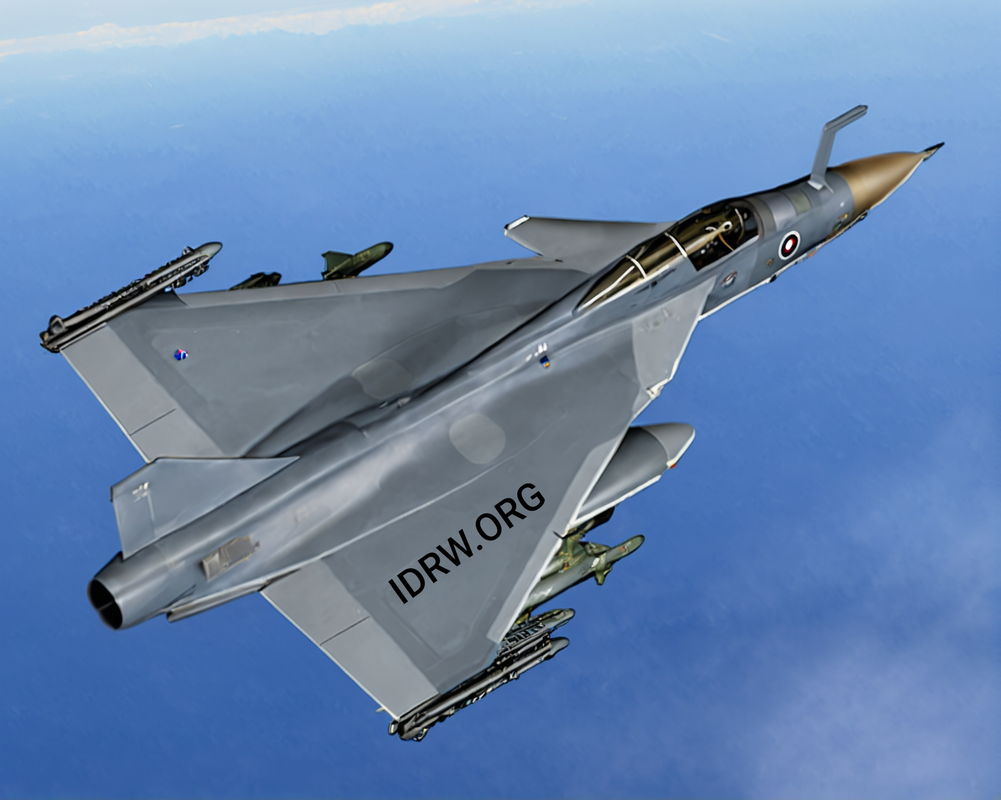SOURCE: RAUNAK KUNDE / NEWS BEAT / IDRW.ORG

The Indian government has clarified that it has not imposed any penalties on GE Aviation for delays in delivering the F404-IN20 engines, essential for Hindustan Aeronautics Limited’s (HAL) production of the Tejas Mk1A Light Combat Aircraft (LCA). The statement comes after recent media reports, specifically from “ThePrint”, suggested that multiple penalties were levied against GE Aerospace due to prolonged delays, which have impacted the indigenous fighter jet’s production timeline.
Contrary to these reports, official sources have confirmed that HAL, which holds the contract with the U.S. aerospace giant GE Aviation, opted not to enforce the financial penalties stipulated in the agreement for supply delays. idrw.org was the first to highlight this issue in its report published on October 24, the decision reflects HAL’s consideration of the broader strategic partnership with GE Aerospace, particularly with the Tejas program’s future engine requirements in mind.
Continue readingSOURCE: RAUNAK KUNDE / NEWS BEAT / IDRW.ORG

Repeated delays and technical issues with the Dhanush 155mm X 45 Calibre Gun have put the Indian Army in a challenging position, prompting a review of its procurement plans. Initially intended to replace ageing Bofors guns in the Army’s artillery regiments, the Dhanush system—developed by the Ordnance Factories Board (OFB) in collaboration with the Indian Army—has struggled with consistent delivery timelines, adding pressure to an already stretched artillery modernization program.
In 2019, the Army placed an order for 114 Dhanush guns, after the system received bulk production clearance in February of that year. The delivery schedule aimed to complete the order by 2022, but as of now, it is anticipated that the Army won’t receive all the guns until mid-2026, and further delays are still possible. These setbacks have led the Army to reconsider its plan to procure more units of the Dhanush gun.
Continue readingSOURCE: RAUNAK KUNDE / NEWS BEAT / IDRW.ORG

The inclusion of canards on the Tejas MkII offers multiple aerodynamic benefits, particularly in enhancing the aircraft’s lift and improving its performance during slow-speed manoeuvres, such as landings and takeoffs. One of the primary functions of canards is to generate additional lift at slower speeds, making them crucial for operations like short takeoff and landing (STOL), which are essential for carrier operations or limited runway availability.
During landings, aircraft are required to operate at lower speeds, and maintaining lift becomes critical. The canards on the Tejas MkII, positioned in a close-coupled configuration just behind the cockpit and slightly ahead of the wings, play a crucial role here. Being close-coupled means the canards interact more efficiently with the airflow over the wings, improving the overall wing-canard interaction. This leads to a significant increase in the lift generated by the wings.
Continue readingSOURCE: AFI

In a recent discussion on India’s Indigenous defence capabilities, Group Captain UK Devnath emphasized significant advancements in the development of the Kaveri engine, primarily focused on addressing critical engineering challenges. With support from the United States, the Defence Research and Development Organisation (DRDO) has acquired state-of-the-art CNC machines, designed for high-precision machining. These machines are capable of achieving Six Sigma standards, indicating a defect rate of just one in one million parts. This technological leap is expected to enhance the manufacturing precision essential for the Kaveri engine’s performance.
One of the most critical challenges in developing the Kaveri engine has been managing the extreme temperatures generated during operation. Group Captain Devnath highlighted that the Indian engineering team has developed a specialized fiber material capable of withstanding temperatures up to 1,700 degrees Celsius. This innovation not only improves the engine’s operational efficiency but also significantly enhances its durability, enabling it to perform under harsh conditions.
Continue readingSOURCE: AFI

In a recent discussion with Syed Muhammad Ali, host of World Echo News, Dr. Mansoor Ahmed, an Honorary Lecturer in the Strategic and Defence Studies Centre at the Australian National University, shared his insights on India’s expanding nuclear capabilities, particularly focusing on the Prototype Fast Breeder Reactor (PFBR) at Kalpakkam, Tamil Nadu. Dr. Ahmed noted that the PFBR’s capability to produce weapons-grade plutonium could allow India to add significantly to its nuclear arsenal, further influencing the region’s strategic landscape.
The 500 MWe PFBR at Kalpakkam is a pivotal part of India’s advanced nuclear program, which aims not only to diversify the nation’s energy sources but also to develop self-sufficiency in plutonium production. Dr. Ahmed highlighted that the reactor, once fully operational, could produce up to 140-150 kg of weapons-grade plutonium annually. This amount would support the development of a significant number of nuclear warheads, as it typically takes around 4-6 kg of weapons-grade plutonium per nuclear weapon. This could mean an increase in India’s nuclear weapon production potential by up to 35 warheads per year from this single reactor alone, based on available plutonium levels.
Continue readingSOURCE: AFI

In a significant development, a newly released video captures the Indian Air Force (IAF) Jaguar strike aircraft firing an AIM-132 Advanced Short-Range Air-to-Air Missile (ASRAAM) from its distinctive over-wing pylon. The ASRAAM integration forms a crucial part of the IAF’s DARIN-III (Display Attack Ranging Inertial Navigation-III) upgrades, which are designed to enhance the Jaguar’s operational capabilities and extend its service life.
The DARIN-III upgrade is an ambitious program by the IAF to revitalize its aging fleet of Jaguar aircraft, which have served as a backbone of India’s ground-attack force for decades. This upgrade integrates advanced avionics, mission computers, multi-function displays, and modern weapon systems. The addition of the AIM-132 ASRAAM as part of the upgrade enhances the Jaguars’ short-range air combat and self-defense capabilities, bringing them in line with contemporary requirements for high-stakes missions.
Continue readingSOURCE: AFI

Bengaluru-based space start-up Pixxel has unveiled its groundbreaking hyperspectral satellites, named Fireflies. These satellites, weighing approximately 50 kg each, are set to revolutionize Earth observation with their unparalleled capabilities.
One of the most remarkable features of Fireflies is their exceptional 5-meter resolution. This is the highest resolution ever achieved by a hyperspectral satellite, allowing for unprecedented detail and accuracy in data collection.
Continue readingSOURCE: AFI

NTPC, India’s largest power generation company, has partnered with the Indian Army to establish a groundbreaking solar hydrogen-based microgrid in Chushul, Ladakh. This innovative project aims to provide a reliable and sustainable power supply to this remote and strategically important region.
The microgrid will independently generate 200 kW of power throughout the year, utilizing green hydrogen as a clean and efficient energy source. By harnessing solar energy to produce hydrogen, the project will significantly reduce carbon emissions and promote energy independence.
Continue readingSOURCE: ANI

The US State Department has welcomed the ‘reduction in tensions’ along the India-China border following the recent disengagement of troops of the two countries, along the Line of Actual Control (LAC).
US State Department Spokesperson, Matthew Miller, said that Washington is closely monitoring the situation, and it also discussed with the Indian side on the matter, but also added that, the US has not played any role in the resolution.
Continue readingSOURCE: IANS

Garden Reach Shipbuilders and Engineers (GRSE) Ltd signed a contract with the Naval Physical and Oceanographic Laboratory (NPOL) on Tuesday for the construction of an Acoustic Research Ship (ARS). NPOL is a laboratory under the Defence Research and Development Organisation (DRDO) and GRSE is upbeat with the signing of the contract as officials believe that it underscores the shipyard’s capability to build state-of-the-art specialised vessels required for research, apart from advanced warships.
The contract was signed in Kochi by Cdr Shantanu Bose, IN (Retd), Director (Shipbuilding), GRSE, and Sijo N Lukose, Sc-G, Group Director (Material Management), NPOL, in the presence of senior officials from both organisations.
Continue readingSOURCE: REUTERS

Facing a shortage of planes due to Western sanctions, Russia is in talks with some Central Asian countries for their airlines to run domestic flights and help meet a pick up in travel demand.
Russian airlines, which use many Western aircraft delivered before the war in Ukraine, are struggling to meet growing demand for air travel as sanctions hinder access to parts and domestic production takes time to ramp up.
Continue readingSOURCE: ANI

External Affairs Minister S Jaishankar on Tuesday stressed the importance of a “whole of the government” approach to effectively advance national security during his address at the Army Commanders Conference in the national capital.
He spoke about the intricacies of current geopolitics including its challenges, possibilities and opportunities. Sharing some pictures of the conference on X, Jaishankar wrote, “Pleased to address the Army Commanders Conference in Delhi today. Discussed the intricacies of current geopolitics, as well as its challenges, possibilities and opportunities. Urged that a more ‘whole of the government’ approach is needed to effectively advance national security.”
Continue readingSOURCE: PTI

At least 19 Naxalites, three of them carrying bounty, were arrested by the security forces in separate operations in Chhattisgarh’s Sukma district, police said on Tuesday, October 29. As many as 14 Naxalites were apprehended from the Jagargunda police station area, while five were caught in the Bhejji police station limits on Sunday, an official said.
Joint teams of the District Reserve Guard (DRG), 219th and 150th battalions of the Central Reserve Police Force and 201st battalion of CoBRA (Commando Battalion for Resolute Action — an elite unit of CRPF) were involved in the two actions, he said.
Continue readingSOURCE: PTI
)
More than 100 flights operated by various Indian airlines received bomb threats on Tuesday, according to sources. In 16 days, over 510 domestic and international flights have got the threats that later turned out to be hoaxes. The threats were issued mostly through social media.
Air India received threats for around 36 flights and IndiGo for about 35 flights. Vistara received the threats for 32 flights, the sources in the know said. “A number of Air India flights were subject to security threats received on social media on 29 October 2024.
Continue readingSOURCE: PTI

A man was arrested here on Tuesday for allegedly placing detonators on the Haridwar-Dehradun railway track in Uttarakhand, officials said.
The Haridwar Government Railway Police (GRP) received information from the control room of Moradabad Railway Division on Sunday night about detonators lying on the railway track near Moti Chur railway station, they said.
Continue reading